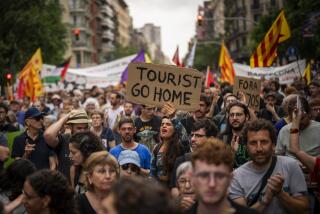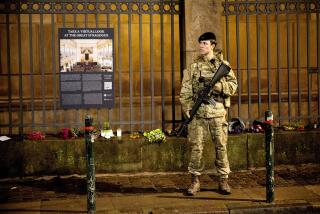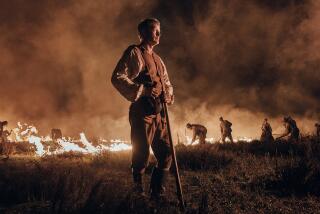Safe Harbor in Copenhagen
- Share via
COPENHAGEN — Word passed quickly that I had boarded the wrong bus and taken it a long way in the wrong direction. Soon nearly every passenger on Copenhagen’s 650S joined an animated discussion of which transfers would get me within steps of the planetarium.
The next day, a fellow passenger advised me to get off at the stop after his. But he skipped his own and walked me to the doorstep of the address I had mentioned. A waiter one evening took me outside to point the way toward a good shopping district, then offered to drive me when he finished his shift.
I had often wondered what kind of people were both descended from Vikings and once led by a king who so strenuously opposed the yellow Star of David ordered by the invading Nazis that no Jews in Denmark were ever forced to wear it. A three-day visit to Denmark’s capital city suggested that they are a people with the clean, orderly efficiency of Germans, the warmth of Italians and the joie de vivre of the French.
This trip was to be my first abroad and the first by air since Sept. 11. I chose my destination cautiously. What, I asked myself, could anyone have against the tiny, virtually defenseless land of Denmark?
I chose my destination well in terms of my security meter, comfortably wandering the streets of central Copenhagen even late at night. Of course, a sense of security isn’t everything, and it isn’t the only thing Copenhagen has to offer. In fact, I came away wondering why the city doesn’t register higher in the consciousness of American travelers. Most U.S. visitors to Denmark are cruise passengers making brief stops. The number of those visitors is likely to grow: Cruise lines are increasingly substituting Scandinavian ports for those in the Mediterranean in the wake of Sept. 11.
But Copenhagen deserves to be considered a destination in its own right, a beautiful, friendly, walkable European city of great history, well established as an arts and cultural center by the 1500s. The Danes are fiercely proud of their architecture and have preserved hundreds of splendid old buildings. My hotel, Nyhavn 71, was built 200 years ago along the harbor that leads to the Baltic Sea. Outside are tall sailing ships, a water taxi and ferryboats. The cobblestone street is lined with brightly colored buildings from the 17th and 18th centuries, most now restaurants and bars.
If led there blindfolded, you might guess you were in Amsterdam, but you would be confused that the water was so clean, the streets so scrubbed. A few blocks away, you would swear you were in Vienna. And every day at noon when the royal family is in town, people gather in front of the palace complex to see the changing of red-coated guards with fuzzy black hats. But you would know you weren’t at Buckingham Palace, because the residences of the royal family are not set back and heavily fenced, but are built around a cul-de-sac that admits both pedestrians and cars.
Three days is not enough in and around Copenhagen, but if that’s all the time you have, here’s the scoop. Upon arrival, don’t be snobby about tours; book one. It will allow you to get your bearings and help you decide--better than a guidebook--what your priorities should be. In summer you can choose from myriad walking, bus and boat tours. In winter, the options narrow to a two-hour bus tour. But after that, add a water taxi around the city for even more perspective.
The water taxi originates on Nyhavn Street, and there, in a tourist office at 65 Nyhavn, you can finalize plans you started stateside to have dinner with a Danish family the following night. The “Meet the Danes” program matches you with someone who speaks your language and shares your interests. Then walk your jet-lagged body along the harbor to meet up with the Stroget, a pedestrians-only street lined with shops and restaurants. Stroll aimlessly and enjoy until dinnertime. Linger in one of the coffee shops with glorious pastries. (What we call danish, the Danes call Viennese bread.) Danish restaurants are supplemented by Asian and Middle Eastern choices. About 7% of Denmark’s residents are foreign born; most live in Copenhagen.
Even before Sept. 11, immigration was shaping up to be a major campaign issue in upcoming elections. The terrorist acts--and an ensuing demonstration in Copenhagen described as anti-Western--have further fueled that debate among Danes already feeling their national identity rocked by the European Union. But you can discuss all that your second night, when, for the price of dinner, you get a homemade meal and an evening of what the Danes call hygge (pronounced HUE-ga). The word is roughly translated as “cozy,” but Danes say there really isn’t an English word for hygge . Having experienced hygge in the home of my Meet the Danes hosts, I think it means something like “open, convivial and friendly feelings between people enjoying themselves in a warm, candle-lighted place.”
On my second day I used the Copenhagen Card, good for bus and train travel and admission to 60 museums and attractions. I started at Amalienborg, the residence of Queen Margrethe, who traces her ancestry back to the Vikings. The palace is a must. The National Museum is superb, with a great section for children. And consider a stop at Tivoli Gardens, which was lighted for Christmas but not yet open during my visit in November. I visited the Experimentarium, a science museum, and saved the zoo, botanical garden and city beaches for what I hope will be a return trip in summer. (Winters there are similar to what you would expect at the same time in New York City.) I regret not reserving enough time for the Rundetarn, an astronomical observatory built in 1642 by King Christian IV.
Even if your trip is short you must reserve a day for a jaunt up the coast to the Louisiana Museum, Fredensborg Castle and the Kronborg Slot--the latter the castle setting for Shakespeare’s “Hamlet.” All are within an hour of the central city and accessible by subsidized and thus cheap trains, or by tour bus. On the other hand, a two-lane road that hugs the coast should make for stress-free driving.
Just north of the city you’ll come upon the Karen Blixen Museum, the estate of the writer Americans know as Isak Dinesen, the author of “Out of Africa” and seven novels. First-rate pastries are sold in the museum cafe. Even if you’re not keen on museums, you can’t help but love the Louisiana, the next major stop to the north. It houses an internationally renowned collection of modern art, but its true greatness is the museum building and its grounds, which stretch to the sea. Nature lovers would be just as happy here as art lovers, but art and nature are so intermingled that it’s hard to tell which you are enjoying at any given moment.
A little farther north, Kronborg Slot soars into view near the town of Elsinore, immortalized by Shakespeare and his Danish prince. The town is also near where Jews smuggled out of Copenhagen were brought to board fishing boats in a short but treacherous journey past Nazi guards and into Sweden. The operators of the tourism office at 65 Nyhavn hope by summer to have a tour that traces the journey. You might have just enough time to take in the Royal Palace at Fredensborg, built in 1740 to celebrate a peace agreement with Sweden, a historic enemy.
My day north of the city ended back in suburban Copenhagen, in the home of Leif and Freya Waeber. My Meet the Danes night happened coincidentally to fall on Morten’s Evening. My host said everyone celebrates Morten’s Evening, but almost no one knows why. He had looked it up so he could tell me the folksy little tale behind it, but no need to know more about it than the Danes do. In practice, it’s a night when friends and family join to eat traditional Danish foods. The main dish is supposed to be goose, but people like duck better, so like many Danes that night, we had duck.
We drank and laughed and exchanged views on politics and religion--the two topics people are supposed to avoid unless they are trusted friends. But after a night of hygge , I think that’s just what we had become.
Guidebook: Cozy in Copenhagen
* Getting there: From Los Angeles, United, American, Alaska, KLM, British Airways, Lufthansa and SAS fly with a change of planes. Restricted round-trip fares begin at $828.
* Telephones: To reach numbers below from the U.S., dial 011 (the international access code), 45 (the country code for Denmark) and the local number.
* Where to stay: The trendiest hotel in Copenhagen is 71 Nyhavn (33-43-62-00, fax 33-43-62-01, https://www.71nyhavnhotelcopenhagen.dk), named for its address in a lively neighborhood along the water. Doubles run about $170-$275.
The Hotel d’Angleterre (34 Kongens Nytorv, 33-37-01-00, fax 33-12-11-18, https://www.remmen.dk/hda.htm), the grande dame of hotels, oozes with Old World charm. Doubles begin at about $300. (Ask for a room away from the street.)
The Ascot Hotel (61 Studie-straede, 33-12-60-00, fax 33-14-60-40, https://www.ascothotel.dk) is near Town Hall Square; doubles with breakfast about $175-$200. (A discount of about $30 is offered for Internet booking.)
For a real budget option, the Bellahoj Vandrerhjem (8 Herbergvejen, Bronshoj, 38-28-97-15, fax 38-89-02-10, https://www.danhostel.dk/soeg.asp) is a clean and pleasant hostel that offers dorm beds for about $11. Family rooms for two to six are also available for $30-$67.
To arrange dinner with a Danish family--or reserve hotel rooms, tours and other services--visit https://www.meetthedanes.dk, call 33-46-46-46 or fax 33-46-46-47.
* For more information: Tourist Boards of Denmark, Finland, Iceland, Norway and Sweden, P.O. Box 4649, Grand Central Station, New York, NY 10163-4649; (212) 885-9700, fax (212) 885-9710, https://www.visitdenmark.com.
*
Cindy Loose is a writer in the Travel section of the Post.
More to Read
Sign up for The Wild
We’ll help you find the best places to hike, bike and run, as well as the perfect silent spots for meditation and yoga.
You may occasionally receive promotional content from the Los Angeles Times.






